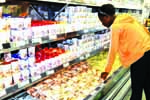Economy: We’re in real trouble

 Happiness Zengeni & Golden Sibanda
Happiness Zengeni & Golden Sibanda
WHILE some sections in this country might hail the country’s low inflation as a good thing, since they have obviously seen it in the high millions, the reality is the downward spiral in the rate is a sign of a weak economy.
According to figures from ZimStats, the annual inflation for October shed 0,28 percentage points to 0,59 percent from 0,86 percent in September as prices have not increased at the same pace as last year owing largely to weak aggregate demand and the continuous slide of the South African rand against the United States dollar.
Prices of basic goods and services have generally remained stable owing to lack of room for retailers to raise prices because disposable incomes are not growing due to the economy’s illiquidity. The economy is now characterised by stagnant salaries and wages with minimal adjustments being made as this will leave less money for working capital for companies.
Annual inflation stood at 2,51 percent in January this year. At the rate at which annual inflation is dropping economic analysts fear the country could be heading into deflation, which is a sign of stunted economic growth and falling prices.
There will be massive price cuts to reach sales targets by major retailers and this will result in a technical fall in inflation and there are fears we may hit negative territory by end of January.
Deflation is undesirable since it may further sterilise already fragile productive capacity. Investment may also fall, leading to further reductions in aggregate demand.
For Zimbabwe this is least desirable due to ever falling consumer spending power, which means less incentive for industrial production due to weak demand for its output.
Generally, textbook answers to falling aggregate demand would be a stimulus either from the central bank, by expanding money supply or by the fiscal authority to increase demand, and for industry to borrow at interest rates below those available to private sector.
But Zimbabwe finds itself in a Catch-22 situation with Treasury and the Reserve Bank of Zimbabwe currently incapacitated to influence money supply and banks’ lending rates.
In response to lack of funding, firms have tried to suppress costs by reducing the head count while others have completely closed shop due to the economic challenges.
This has resulted in the number of people with disposable incomes dropping. For those that still spend, low wages have suppressed the latitude of their potential to buy. This is, however, not to imply galloping inflation would be a desirable situation. Under normal economic conditions annual inflation below 5 percent is considered tolerable. This assumes conditions where there is production and adequate money supply.
Harare-based economic analyst Dr John Robertson said the annual inflation has continued trending downward since January this year on weak consumer spending. The weak demand is due to constrained consumer spending capacity in an illiquid economy where retailers have been forced to hold down prices and in the process forfeit profits.
He said Zimbabwe was in a period of disinflation, which in itself was not an encouraging development because by holding down prices amid increasing costs due to rising wage costs retailers were sacrificing profitability.
“It is not a good sign. Demand is shrinking because the buying power of Zimbabweans is shrinking because of lack of jobs due to company closures. This has forced supermarkets and retailers into holding down prices … forfeiting profits even though costs have been going up, which means there will be less money for investment. There will be no new jobs; investment is where new jobs come from,” Dr Robertson said
Government needed to craft policies that boost investor confidence to allow fresh inflows of capital that will boost economic activity and job creation. He also called on Government to invest in and address factors constraining agricultural productivity, which supplies most raw materials to the manufacturing sector, he added.
Shortage of raw materials due to constrained industrial and agricultural production and productivity has conspired to inflate Zimbabwe’s import bill. This has worsened domestic liquidity as the little available funds are siphoned out of the economy.
University of Zimbabwe economics lecturer Professor Tony Hawkins said the country risked falling into deflation, which is an undesirable element of an economic cycle. “I do not think it is a good thing. Countries such as the US get worried when the rate of (annual) inflation gets closer to 1 percent. It is a sign of a weak economy,” he said.
Professor Hawkins said the trend regarding the decline in the annual rate of inflation was a result of tight liquidity and a high unemployment rate, hence poor demand. He also said the tight liquidity in the economy has been reflected in marginal growth in bank deposits and worsening balance of payments, resulting in tight liquidity.
A weakening South African rand has meant imports from Zimbabwe’s southern neighbour have become even cheaper with less of the greenback required to buy import. Zimbabwe imports 60 percent of the basic commodities it consumes from South Africa.










Comments